An Analysis of Cultural Differences and Similarities in the Workplace
VerifiedAdded on 2019/12/18
|9
|1934
|255
Report
AI Summary
This report provides an analysis of cultural differences and similarities in the workplace, specifically focusing on a comparison between Indian and American cultures. The author begins with cultural autobiographies of two individuals, setting the stage for an exploration of how cultural backgrounds influence workplace communication. The report leverages Hofstede's cultural dimensions theory to highlight key differences, such as power distance, individualism versus collectivism, and time orientation. It then shifts to identifying similarities, including democratic political cultures and the adoption of certain cultural aspects. The analysis covers various factors, including family structures, work ethics, and the impact of globalization on both cultures. The conclusion emphasizes the importance of understanding these cultural nuances for effective intercultural communication in a globalized work environment.
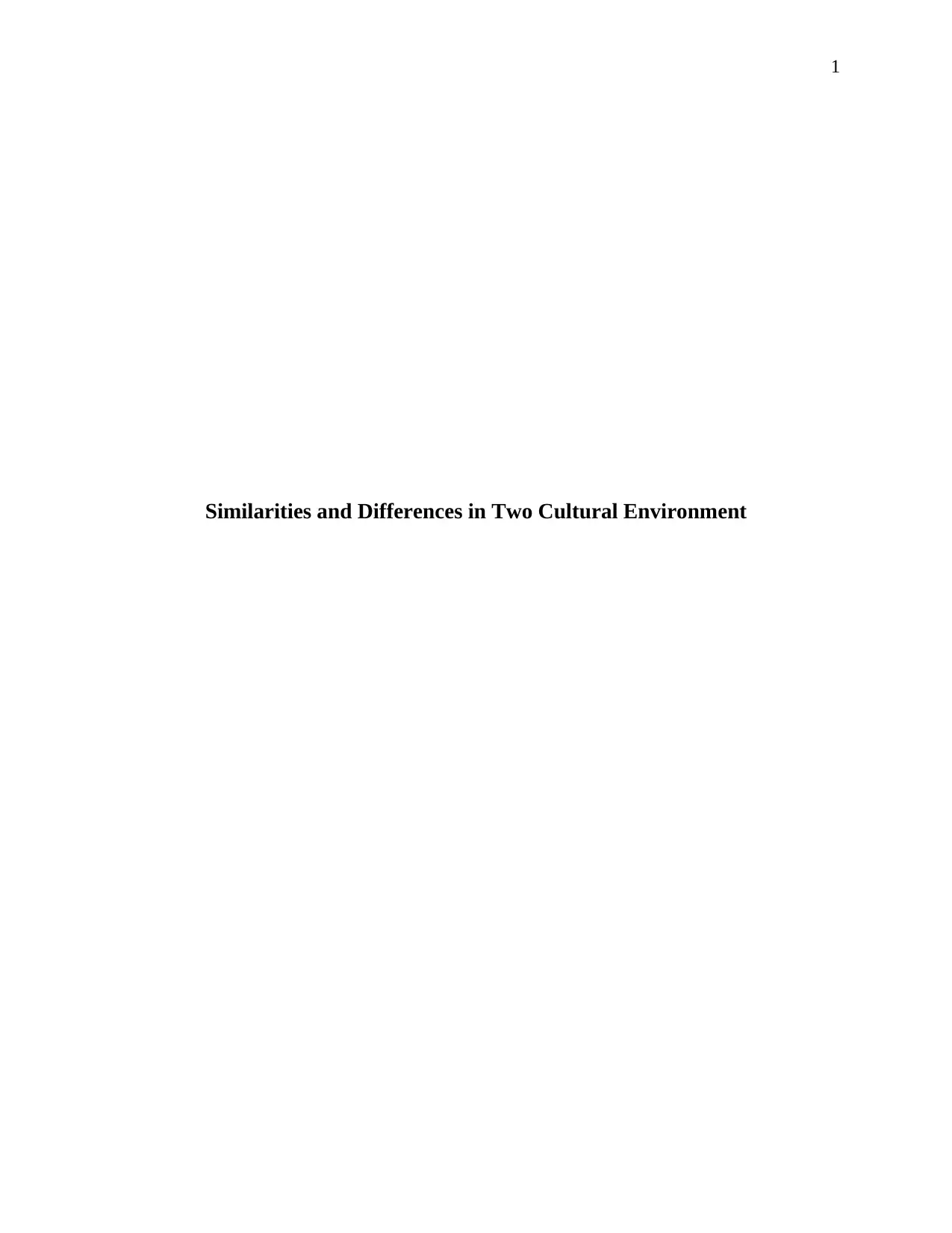
1
Similarities and Differences in Two Cultural Environment
Similarities and Differences in Two Cultural Environment
Paraphrase This Document
Need a fresh take? Get an instant paraphrase of this document with our AI Paraphraser
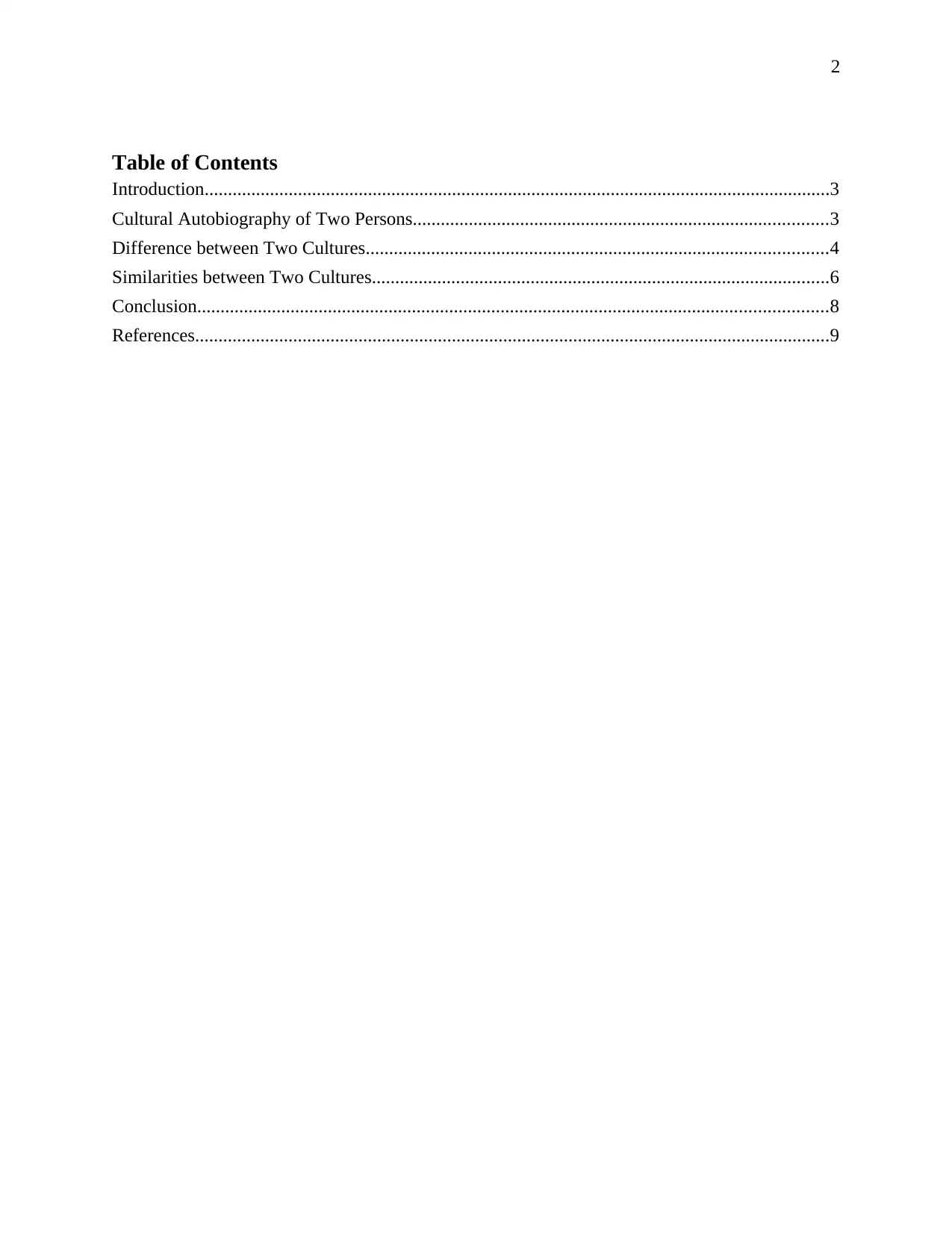
2
Table of Contents
Introduction......................................................................................................................................3
Cultural Autobiography of Two Persons.........................................................................................3
Difference between Two Cultures...................................................................................................4
Similarities between Two Cultures..................................................................................................6
Conclusion.......................................................................................................................................8
References........................................................................................................................................9
Table of Contents
Introduction......................................................................................................................................3
Cultural Autobiography of Two Persons.........................................................................................3
Difference between Two Cultures...................................................................................................4
Similarities between Two Cultures..................................................................................................6
Conclusion.......................................................................................................................................8
References........................................................................................................................................9

3
Introduction
Today, the world is getting smaller with the time as technology made people so close. Early,
communication between two different cultural people was too tough due to less technological
dependency. Communication between two or more people from different linguistic and cultural
origins is called as intercultural communication. Due to different culture, people face problems at
workplace such as language, tradition, working condition, organizational framework etc.
(Sundem, 2014). This paper covers biographies of two persons that belong to different cultures.
It also emphasis over how cultural difference affect workplace communication and what
similarities and differences the two people have. The intercultural communication is elaborated
through different theories presented by famous researchers.
Cultural Autobiography of Two Persons
Autobiography is all about a person’s personal information in a story format where a person
shares memories to others. The culture is defined as a set of interpretations that a person learns
from surrounding, which affect other people’s behavior largely. A person’s beliefs, values and
norms are the aspect through which one’s culture can be identified. Workplace is the place
where different people come together to attain organizational goals and in this process they get
contacted to each other (Cooper, He and B. Levin, 2011). At the time of communication at
workplace some people face difficulties to get adjust due to belonging from different culture. In
other words, different cultured people suffer with dissimilar interpretations by others that create
conflict in behavior is called intercultural communication.
Introduction
Today, the world is getting smaller with the time as technology made people so close. Early,
communication between two different cultural people was too tough due to less technological
dependency. Communication between two or more people from different linguistic and cultural
origins is called as intercultural communication. Due to different culture, people face problems at
workplace such as language, tradition, working condition, organizational framework etc.
(Sundem, 2014). This paper covers biographies of two persons that belong to different cultures.
It also emphasis over how cultural difference affect workplace communication and what
similarities and differences the two people have. The intercultural communication is elaborated
through different theories presented by famous researchers.
Cultural Autobiography of Two Persons
Autobiography is all about a person’s personal information in a story format where a person
shares memories to others. The culture is defined as a set of interpretations that a person learns
from surrounding, which affect other people’s behavior largely. A person’s beliefs, values and
norms are the aspect through which one’s culture can be identified. Workplace is the place
where different people come together to attain organizational goals and in this process they get
contacted to each other (Cooper, He and B. Levin, 2011). At the time of communication at
workplace some people face difficulties to get adjust due to belonging from different culture. In
other words, different cultured people suffer with dissimilar interpretations by others that create
conflict in behavior is called intercultural communication.
⊘ This is a preview!⊘
Do you want full access?
Subscribe today to unlock all pages.

Trusted by 1+ million students worldwide

4
Difference between Two Cultures
India and US are two different countries where beliefs, norms and values concern. I am born and
brought up in India initially. I have studied in India and completed my high school education
after that I have moved to America and completed graduation and masters there. Right now, I am
working in an American corporation where I met many Indian colleagues but I teamed with an
American boy to attain certain task. As, my culture is different from him I have faced a lot
difficulties to develop a healthy relationship. With the help of Hofstede cultural theory the
difference between both us can be determined effectively.
Hofstede is presented a cultural theory called, Layers of Onion that described culture as a series
of layers. The core layer stands for values which is less movable and that does not want to
change and not needed at workplace relationship building process. The first layer around the core
is rituals that play important role at workplace behavior (Anca and Vega, 2016). American
people are more practical and can their rituals accordingly but Indians are very strict and
conscious about their rituals. With the use of layered culture theory, I made him comfortable and
share his beliefs and choices to me alike the second core layer reflects. His representation of hero
is far different from mine he prefers a supermodel as a hero and I admire well stabilized business
personalities. Difference between symbols also important as India and America has different
flags, live with different architecture and prefer to wear different traditional clothing. These three
layers rituals, heroes and symbols have helped me to develop healthy relationship with several
practices between oboth of us as Hofstede represented (Nakata, 2009).
Difference between Two Cultures
India and US are two different countries where beliefs, norms and values concern. I am born and
brought up in India initially. I have studied in India and completed my high school education
after that I have moved to America and completed graduation and masters there. Right now, I am
working in an American corporation where I met many Indian colleagues but I teamed with an
American boy to attain certain task. As, my culture is different from him I have faced a lot
difficulties to develop a healthy relationship. With the help of Hofstede cultural theory the
difference between both us can be determined effectively.
Hofstede is presented a cultural theory called, Layers of Onion that described culture as a series
of layers. The core layer stands for values which is less movable and that does not want to
change and not needed at workplace relationship building process. The first layer around the core
is rituals that play important role at workplace behavior (Anca and Vega, 2016). American
people are more practical and can their rituals accordingly but Indians are very strict and
conscious about their rituals. With the use of layered culture theory, I made him comfortable and
share his beliefs and choices to me alike the second core layer reflects. His representation of hero
is far different from mine he prefers a supermodel as a hero and I admire well stabilized business
personalities. Difference between symbols also important as India and America has different
flags, live with different architecture and prefer to wear different traditional clothing. These three
layers rituals, heroes and symbols have helped me to develop healthy relationship with several
practices between oboth of us as Hofstede represented (Nakata, 2009).
Paraphrase This Document
Need a fresh take? Get an instant paraphrase of this document with our AI Paraphraser

5
Hofstede has presented another theory to understand intercultural communication in a better
way. Through the six dimensions, it can be easily recognized that how different the Indian
culture is from American. Below is the table that shows difference between two cultures on the
basis of Hofsede cultural dominations:
Indian Culture American Culture
High power distance Low power distance
Low uncertainty avoidance High uncertainty avoidance
Collectivism Individualism
Masculinity Femininity
Long term orientation Short term orientation
Restraint Indulgence
Above table shows that both American and Indian cultures are far different with each other. I am
belongs to the country that believes in top-down structure in society and organization whereas
American culture believes that every individual is different but should be treated equally. In
India people stick to the rules and tolerance of unexpected is high as compare to American
Hofstede has presented another theory to understand intercultural communication in a better
way. Through the six dimensions, it can be easily recognized that how different the Indian
culture is from American. Below is the table that shows difference between two cultures on the
basis of Hofsede cultural dominations:
Indian Culture American Culture
High power distance Low power distance
Low uncertainty avoidance High uncertainty avoidance
Collectivism Individualism
Masculinity Femininity
Long term orientation Short term orientation
Restraint Indulgence
Above table shows that both American and Indian cultures are far different with each other. I am
belongs to the country that believes in top-down structure in society and organization whereas
American culture believes that every individual is different but should be treated equally. In
India people stick to the rules and tolerance of unexpected is high as compare to American
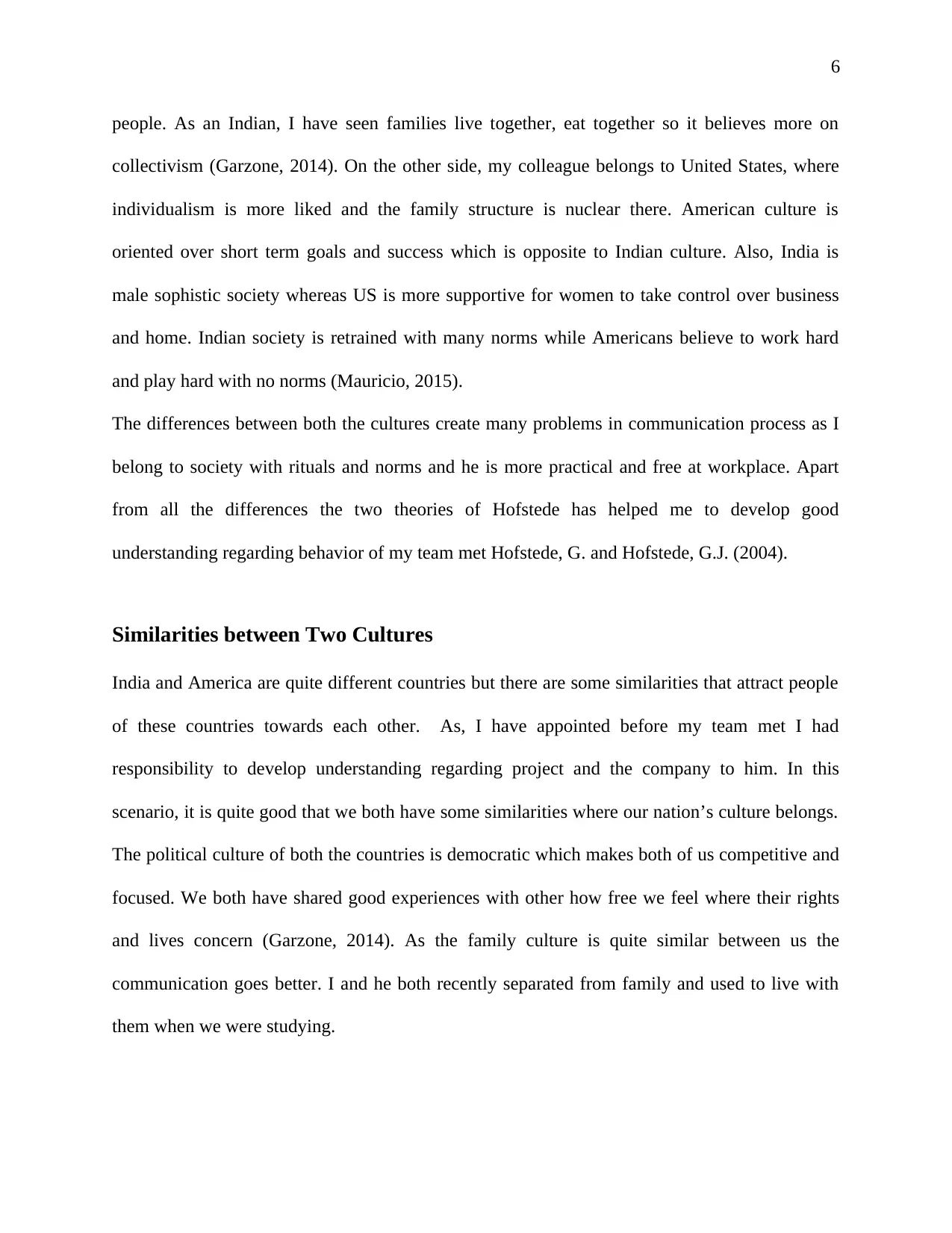
6
people. As an Indian, I have seen families live together, eat together so it believes more on
collectivism (Garzone, 2014). On the other side, my colleague belongs to United States, where
individualism is more liked and the family structure is nuclear there. American culture is
oriented over short term goals and success which is opposite to Indian culture. Also, India is
male sophistic society whereas US is more supportive for women to take control over business
and home. Indian society is retrained with many norms while Americans believe to work hard
and play hard with no norms (Mauricio, 2015).
The differences between both the cultures create many problems in communication process as I
belong to society with rituals and norms and he is more practical and free at workplace. Apart
from all the differences the two theories of Hofstede has helped me to develop good
understanding regarding behavior of my team met Hofstede, G. and Hofstede, G.J. (2004).
Similarities between Two Cultures
India and America are quite different countries but there are some similarities that attract people
of these countries towards each other. As, I have appointed before my team met I had
responsibility to develop understanding regarding project and the company to him. In this
scenario, it is quite good that we both have some similarities where our nation’s culture belongs.
The political culture of both the countries is democratic which makes both of us competitive and
focused. We both have shared good experiences with other how free we feel where their rights
and lives concern (Garzone, 2014). As the family culture is quite similar between us the
communication goes better. I and he both recently separated from family and used to live with
them when we were studying.
people. As an Indian, I have seen families live together, eat together so it believes more on
collectivism (Garzone, 2014). On the other side, my colleague belongs to United States, where
individualism is more liked and the family structure is nuclear there. American culture is
oriented over short term goals and success which is opposite to Indian culture. Also, India is
male sophistic society whereas US is more supportive for women to take control over business
and home. Indian society is retrained with many norms while Americans believe to work hard
and play hard with no norms (Mauricio, 2015).
The differences between both the cultures create many problems in communication process as I
belong to society with rituals and norms and he is more practical and free at workplace. Apart
from all the differences the two theories of Hofstede has helped me to develop good
understanding regarding behavior of my team met Hofstede, G. and Hofstede, G.J. (2004).
Similarities between Two Cultures
India and America are quite different countries but there are some similarities that attract people
of these countries towards each other. As, I have appointed before my team met I had
responsibility to develop understanding regarding project and the company to him. In this
scenario, it is quite good that we both have some similarities where our nation’s culture belongs.
The political culture of both the countries is democratic which makes both of us competitive and
focused. We both have shared good experiences with other how free we feel where their rights
and lives concern (Garzone, 2014). As the family culture is quite similar between us the
communication goes better. I and he both recently separated from family and used to live with
them when we were studying.
⊘ This is a preview!⊘
Do you want full access?
Subscribe today to unlock all pages.

Trusted by 1+ million students worldwide
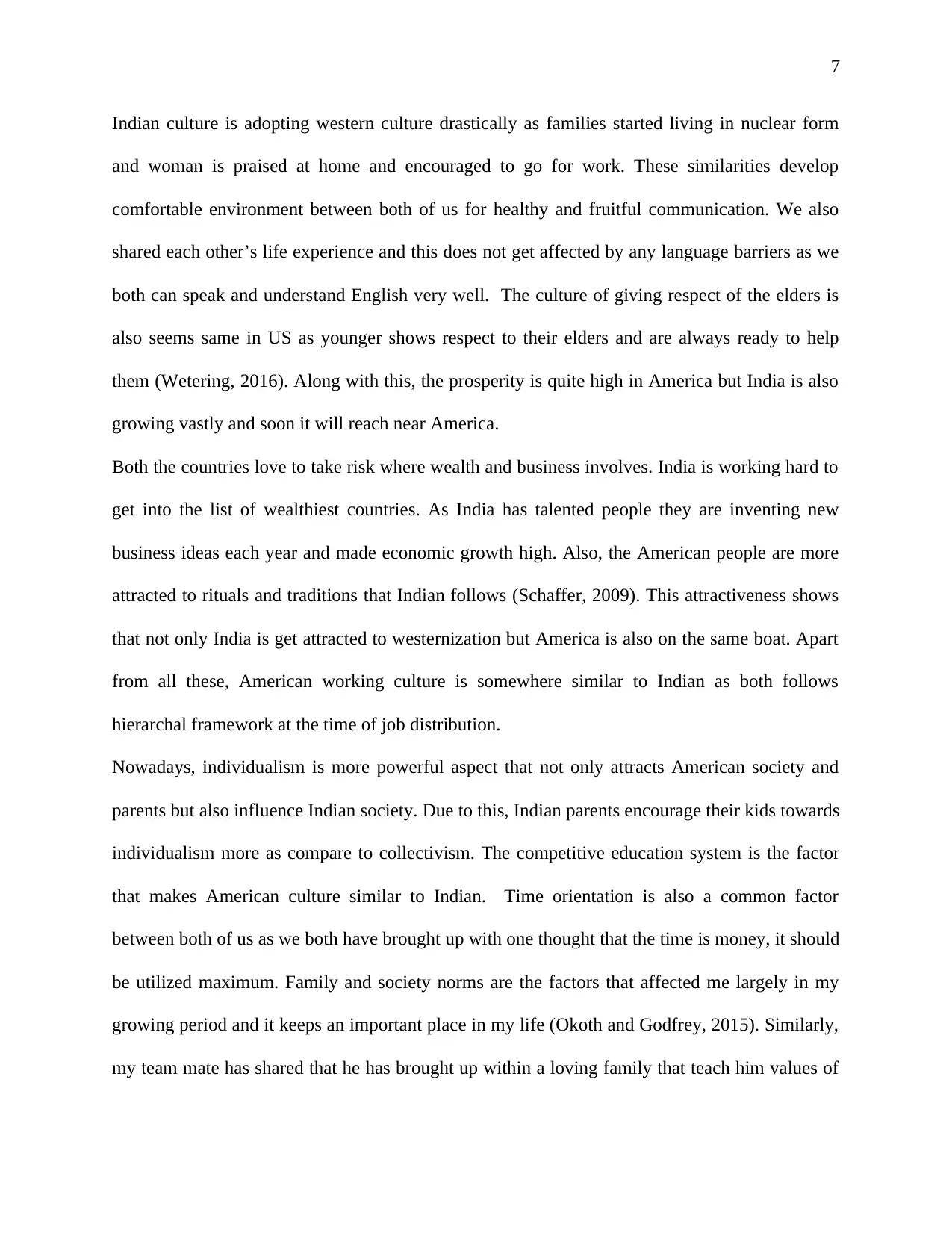
7
Indian culture is adopting western culture drastically as families started living in nuclear form
and woman is praised at home and encouraged to go for work. These similarities develop
comfortable environment between both of us for healthy and fruitful communication. We also
shared each other’s life experience and this does not get affected by any language barriers as we
both can speak and understand English very well. The culture of giving respect of the elders is
also seems same in US as younger shows respect to their elders and are always ready to help
them (Wetering, 2016). Along with this, the prosperity is quite high in America but India is also
growing vastly and soon it will reach near America.
Both the countries love to take risk where wealth and business involves. India is working hard to
get into the list of wealthiest countries. As India has talented people they are inventing new
business ideas each year and made economic growth high. Also, the American people are more
attracted to rituals and traditions that Indian follows (Schaffer, 2009). This attractiveness shows
that not only India is get attracted to westernization but America is also on the same boat. Apart
from all these, American working culture is somewhere similar to Indian as both follows
hierarchal framework at the time of job distribution.
Nowadays, individualism is more powerful aspect that not only attracts American society and
parents but also influence Indian society. Due to this, Indian parents encourage their kids towards
individualism more as compare to collectivism. The competitive education system is the factor
that makes American culture similar to Indian. Time orientation is also a common factor
between both of us as we both have brought up with one thought that the time is money, it should
be utilized maximum. Family and society norms are the factors that affected me largely in my
growing period and it keeps an important place in my life (Okoth and Godfrey, 2015). Similarly,
my team mate has shared that he has brought up within a loving family that teach him values of
Indian culture is adopting western culture drastically as families started living in nuclear form
and woman is praised at home and encouraged to go for work. These similarities develop
comfortable environment between both of us for healthy and fruitful communication. We also
shared each other’s life experience and this does not get affected by any language barriers as we
both can speak and understand English very well. The culture of giving respect of the elders is
also seems same in US as younger shows respect to their elders and are always ready to help
them (Wetering, 2016). Along with this, the prosperity is quite high in America but India is also
growing vastly and soon it will reach near America.
Both the countries love to take risk where wealth and business involves. India is working hard to
get into the list of wealthiest countries. As India has talented people they are inventing new
business ideas each year and made economic growth high. Also, the American people are more
attracted to rituals and traditions that Indian follows (Schaffer, 2009). This attractiveness shows
that not only India is get attracted to westernization but America is also on the same boat. Apart
from all these, American working culture is somewhere similar to Indian as both follows
hierarchal framework at the time of job distribution.
Nowadays, individualism is more powerful aspect that not only attracts American society and
parents but also influence Indian society. Due to this, Indian parents encourage their kids towards
individualism more as compare to collectivism. The competitive education system is the factor
that makes American culture similar to Indian. Time orientation is also a common factor
between both of us as we both have brought up with one thought that the time is money, it should
be utilized maximum. Family and society norms are the factors that affected me largely in my
growing period and it keeps an important place in my life (Okoth and Godfrey, 2015). Similarly,
my team mate has shared that he has brought up within a loving family that teach him values of
Paraphrase This Document
Need a fresh take? Get an instant paraphrase of this document with our AI Paraphraser
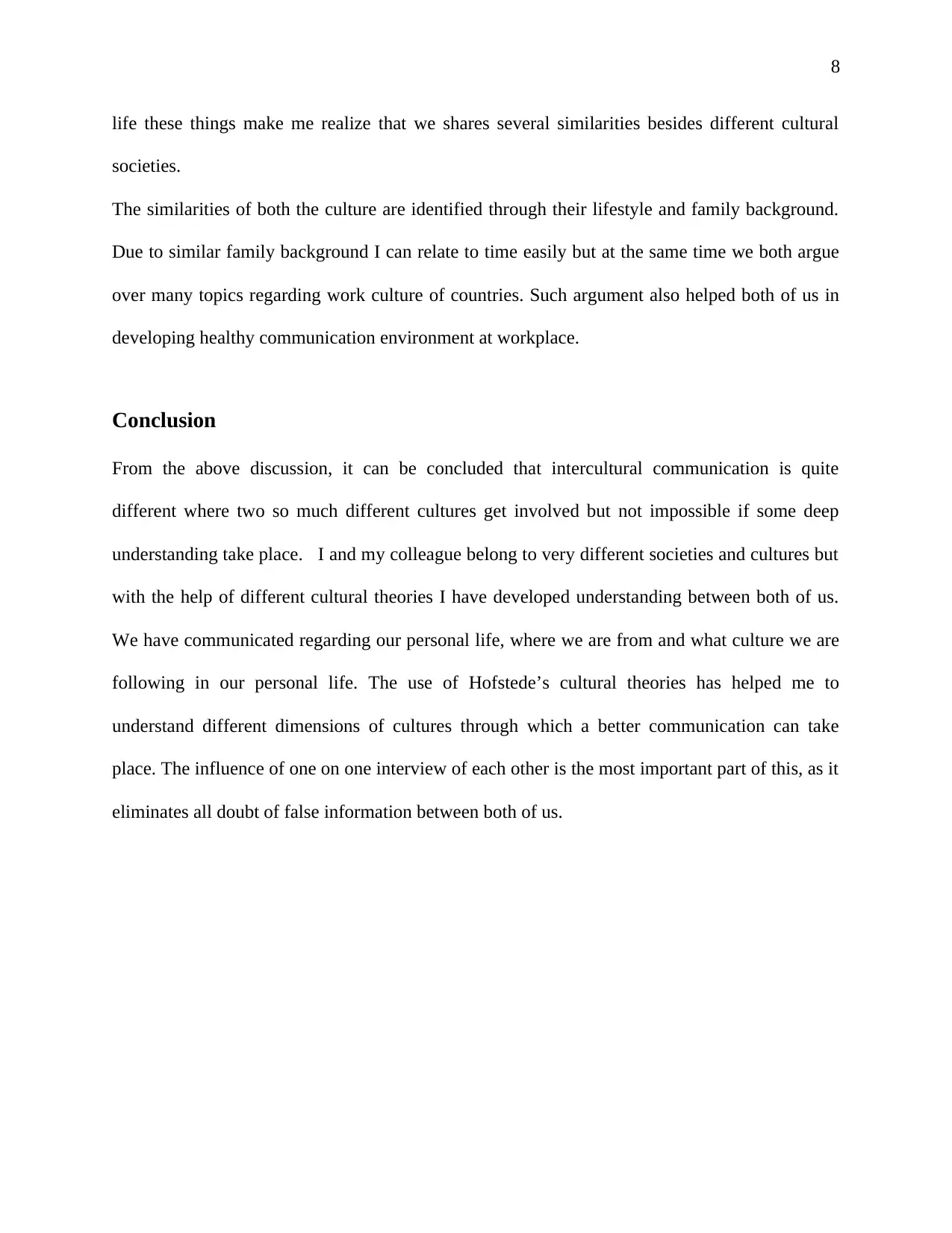
8
life these things make me realize that we shares several similarities besides different cultural
societies.
The similarities of both the culture are identified through their lifestyle and family background.
Due to similar family background I can relate to time easily but at the same time we both argue
over many topics regarding work culture of countries. Such argument also helped both of us in
developing healthy communication environment at workplace.
Conclusion
From the above discussion, it can be concluded that intercultural communication is quite
different where two so much different cultures get involved but not impossible if some deep
understanding take place. I and my colleague belong to very different societies and cultures but
with the help of different cultural theories I have developed understanding between both of us.
We have communicated regarding our personal life, where we are from and what culture we are
following in our personal life. The use of Hofstede’s cultural theories has helped me to
understand different dimensions of cultures through which a better communication can take
place. The influence of one on one interview of each other is the most important part of this, as it
eliminates all doubt of false information between both of us.
life these things make me realize that we shares several similarities besides different cultural
societies.
The similarities of both the culture are identified through their lifestyle and family background.
Due to similar family background I can relate to time easily but at the same time we both argue
over many topics regarding work culture of countries. Such argument also helped both of us in
developing healthy communication environment at workplace.
Conclusion
From the above discussion, it can be concluded that intercultural communication is quite
different where two so much different cultures get involved but not impossible if some deep
understanding take place. I and my colleague belong to very different societies and cultures but
with the help of different cultural theories I have developed understanding between both of us.
We have communicated regarding our personal life, where we are from and what culture we are
following in our personal life. The use of Hofstede’s cultural theories has helped me to
understand different dimensions of cultures through which a better communication can take
place. The influence of one on one interview of each other is the most important part of this, as it
eliminates all doubt of false information between both of us.
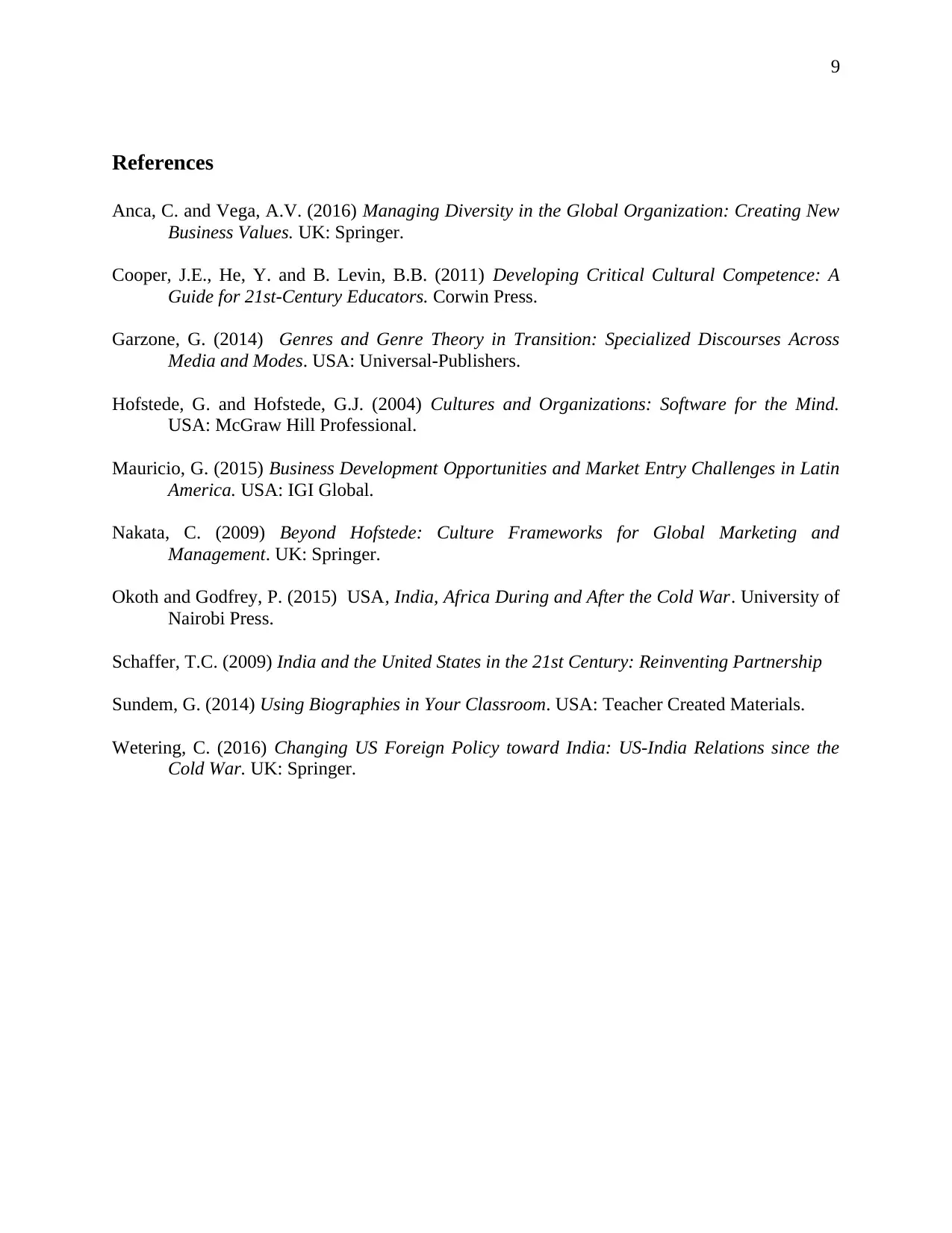
9
References
Anca, C. and Vega, A.V. (2016) Managing Diversity in the Global Organization: Creating New
Business Values. UK: Springer.
Cooper, J.E., He, Y. and B. Levin, B.B. (2011) Developing Critical Cultural Competence: A
Guide for 21st-Century Educators. Corwin Press.
Garzone, G. (2014) Genres and Genre Theory in Transition: Specialized Discourses Across
Media and Modes. USA: Universal-Publishers.
Hofstede, G. and Hofstede, G.J. (2004) Cultures and Organizations: Software for the Mind.
USA: McGraw Hill Professional.
Mauricio, G. (2015) Business Development Opportunities and Market Entry Challenges in Latin
America. USA: IGI Global.
Nakata, C. (2009) Beyond Hofstede: Culture Frameworks for Global Marketing and
Management. UK: Springer.
Okoth and Godfrey, P. (2015) USA, India, Africa During and After the Cold War. University of
Nairobi Press.
Schaffer, T.C. (2009) India and the United States in the 21st Century: Reinventing Partnership
Sundem, G. (2014) Using Biographies in Your Classroom. USA: Teacher Created Materials.
Wetering, C. (2016) Changing US Foreign Policy toward India: US-India Relations since the
Cold War. UK: Springer.
References
Anca, C. and Vega, A.V. (2016) Managing Diversity in the Global Organization: Creating New
Business Values. UK: Springer.
Cooper, J.E., He, Y. and B. Levin, B.B. (2011) Developing Critical Cultural Competence: A
Guide for 21st-Century Educators. Corwin Press.
Garzone, G. (2014) Genres and Genre Theory in Transition: Specialized Discourses Across
Media and Modes. USA: Universal-Publishers.
Hofstede, G. and Hofstede, G.J. (2004) Cultures and Organizations: Software for the Mind.
USA: McGraw Hill Professional.
Mauricio, G. (2015) Business Development Opportunities and Market Entry Challenges in Latin
America. USA: IGI Global.
Nakata, C. (2009) Beyond Hofstede: Culture Frameworks for Global Marketing and
Management. UK: Springer.
Okoth and Godfrey, P. (2015) USA, India, Africa During and After the Cold War. University of
Nairobi Press.
Schaffer, T.C. (2009) India and the United States in the 21st Century: Reinventing Partnership
Sundem, G. (2014) Using Biographies in Your Classroom. USA: Teacher Created Materials.
Wetering, C. (2016) Changing US Foreign Policy toward India: US-India Relations since the
Cold War. UK: Springer.
⊘ This is a preview!⊘
Do you want full access?
Subscribe today to unlock all pages.

Trusted by 1+ million students worldwide
1 out of 9
Related Documents
Your All-in-One AI-Powered Toolkit for Academic Success.
+13062052269
info@desklib.com
Available 24*7 on WhatsApp / Email
![[object Object]](/_next/static/media/star-bottom.7253800d.svg)
Unlock your academic potential
Copyright © 2020–2025 A2Z Services. All Rights Reserved. Developed and managed by ZUCOL.




